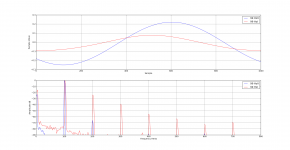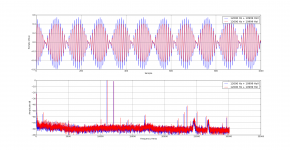Sound Lab electrostat speakers in a good room sure help a lot with producing a wonderful soundstage. For box speakers, I am told Vienna Acoustics is a wise choice.
Relevant measurement that matters to perceived sound has to be done on the acoustic output. Measurements on amps or speakers or whatever alone can not correlate well with perceived differences. Hence the recurring fight to the death dispute over correlation of irrelevant measurement.
@peufeu,
Its a bit complicated. Where are you starting from? You already aware of existing literature on speakers and rooms?
Its a bit complicated. Where are you starting from? You already aware of existing literature on speakers and rooms?
Relevant measurement that matters to perceived sound has to be done on the acoustic output.
If the amp screwed with the signal, the speakers won't fix it.
If something in the chain screwed with the signal and you measure only the complete chain, you'll have no idea where the problem is.
That said, you're right: measuring an amplifier on a resistive load, then using it on speakers is quite useless. It's like tuning the suspensions of your car while driving on carpet.
@peufeu,
Its a bit complicated. Where are you starting from? You already aware of existing literature on speakers and rooms?
Yeah, I need constant directivity speakers. But this is a topic about opamps.
What if you need someone to listen with their ears so that they can recommend a more involved/non-standard measurement to "detect" or quantity an undesired artifact (using their experience to make the recommendation)? (What if that someone is a customer who is using your parts in their product?)
What if your standard test rack and standard specifications can not do that measurement? And you need to make a new/modified test setup?
Telling them it is irrelevant rarely works out well.
What if your standard test rack and standard specifications can not do that measurement? And you need to make a new/modified test setup?
Telling them it is irrelevant rarely works out well.
Last edited:
What if your standard test rack and standard specifications can not do that measurement? And you need to make a new/modified test setup?
If you see something you can't measure, you build an instrument that can measure it. I'm doing that at the moment. It is quite surprising that pretty much no one does that. Comfort, I guess. Many designers optimize for a set of standard measurements that characterize performance on zero-centered sinewaves in a resistive load. So they build amps that are good at zero-centered sinewaves in a resistive load.
A lot of crazy audiophile stuff like bi-wiring or fast/soft rectifiers produce easily measurable effects if you look in the right place.
If you see something you can't measure, you build an instrument that can measure it.
Yes. This is a normal thing. Building to paper specifications alone with parts with their own paper specifications is not normal or recommended.
We have cases of "improved" part with "much better specification" blew up on numerous applications due to oscillation, development of hot spot or something else where the supposedly "outdated with lower specification" part works just fine. It is highly improbable for published specifications to cover everything.
If you see something you can't measure, you build an instrument that can measure it. I'm doing that at the moment. It is quite surprising that pretty much no one does that. Comfort, I guess. Many designers optimize for a set of standard measurements that characterize performance on zero-centered sinewaves in a resistive load. So they build amps that are good at zero-centered sinewaves in a resistive load.
A lot of crazy audiophile stuff like bi-wiring or fast/soft rectifiers produce easily measurable effects if you look in the right place.
Please keep us updated on your new measurement practises, I'm very interested.
We have cases of "improved" part with "much better specification" blew up on numerous applications due to oscillation, development of hot spot or something else where the supposedly "outdated with lower specification" part works just fine. It is highly improbable for published specifications to cover everything.
Can't slap in a 50MHz opamp without thinking about layout and decoupling.
When I changed the crummy old 4559 opamps in the TEAC I was careful to pick some with good specs but a lowish gain-bandwidth so it would be happy on the old single layer PCB with decoupling caps a mile away. I think it was one of the OPAsomething from TI. It works very well, and sounds much better.
I'd guesstimate about a lot of the differences heard by opamp rollers (and the fact they disagree and flame each other so much) come from spurious HF behavior due to highspeed opamps used where they shouldn't. Probably why it's so hit and miss and an opamp works great on one board and sucks on another.
Please keep us updated on your new measurement practises, I'm very interested.
I'm laying out the boards. Meanwhile, about the other two "myths" I quoted:
Bi-wiring:
Stick a resistor in series with your speaker to measure current, play a sweep, measure THD on current using your favorite software. Attached is my desktop speakers at 100Hz, don't remember the amplitude:

THD on current drawn by woofers is ridiculously high. The harmonics of current drawn by the woofer will create a (distortion) voltage on the cable according to its impedance, and the whole loudspeaker will reproduce that distortion, since from the speaker's point of view, it's voltage on its terminals, therefore it is signal, and it is its job to reproduce it. If you use bi-wiring then at least the tweeter won't reproduce the harmonics created by woofer current over shared cable impedance...
Fast/soft rectifiers:
It's easy to measure the ringing...
interestsing point. Assume 8ohm speaker and 0.8Ohms cable resistance, inductance neglected and the added H2-distortion of 100Hz would be in the ballpark of 1%. The higher harmonics drop to 0.1%. Do you think this is something contributing to audible distortion produced by the tweeter?
Meanwhile, about the other two...
Those are easy ones. There are much harder ones that might give you some trouble. Doesn't mean you won't figure them out, but it could take a lot of time and effort.
bucks bunny> It's possible...
It works both ways. 11+12kHz intermodulation in the tweeter and its crossover produces 1kHz distortion which will be reproduced by the woofer too.
But this current distortion thingy is mostly an argument for thick cables, or even better, monoblocks or speakers with integrated amps so you just have short cable, no cable capacitance, so no output inductor, so minimum amplifier output Z. Also active crossover.
Which ones? Hold my beer.
It works both ways. 11+12kHz intermodulation in the tweeter and its crossover produces 1kHz distortion which will be reproduced by the woofer too.
But this current distortion thingy is mostly an argument for thick cables, or even better, monoblocks or speakers with integrated amps so you just have short cable, no cable capacitance, so no output inductor, so minimum amplifier output Z. Also active crossover.
There are much harder ones that might give you some trouble.
Which ones? Hold my beer.
Attachments
If you would not always speak in mysteries then maybe we could learn something...
Okay. Here is an audiophile type test: There is a Janis Ian song on CD, the song is "Breaking Silence." Near the beginning and then once more later in the song there is a vocal passage where the singer's voice is layered in multiple places in the stereo illusion sound stage. The question is: how many distinct voices can you hear and where is each one located in the sound stage in coordinates from left to right and in depth from close to the mic or far away?
In a good system there are 4 distinct voices located a little bit to the left/right of each other, and they are all at different depths (distance from the listener).
With my AK4499 dac, Sound Lab speakers, and either the AHB2 or Aragon power amps, I am getting about three and a half voices. Location of each from left to right is very well defined. Depth is harder. There are three distinct depths but the furthest two voices are kind of blurred together. It is apparent that there is more than one voice, but they are not very distinct from each other.
The test results indicate a problem with fully reproducing low level room decay sounds. Could be a problem with my room, could be with the dac, could be the CD recording. At least those seem like the most likely.
I am told that on a good, expertly setup phono system the stereo illusion of the voice locations is more distinct than on the best of digital systems. I have no first hand knowledge of that. However, pretty soon a very good phono system will be here so I can find out if there is a problem is with anything after the dac (power amp, speakers, room).
Last edited:
You left out the real most likely causes, your listening position change and aural memory fade due to slow switching of device/s in comparison.Could be a problem with my room, could be with the dac, could be the CD recording. At least those seem like the most likely.
He has an affiliation with one .He's not in the business
I am getting about three and a half voices.
I get only 3.3 voices.
- Home
- Amplifiers
- Solid State
- Choosing of best sounding OP AMPs for the lowest possible THD+N -really the best Way?
